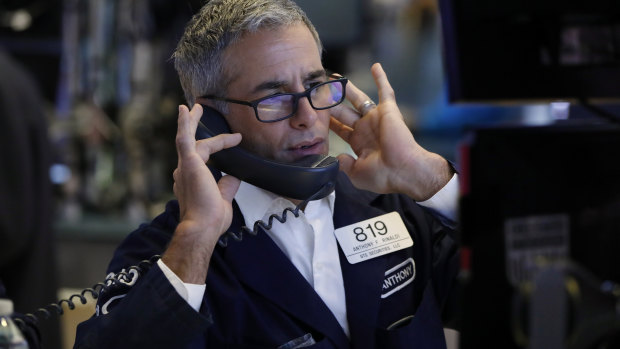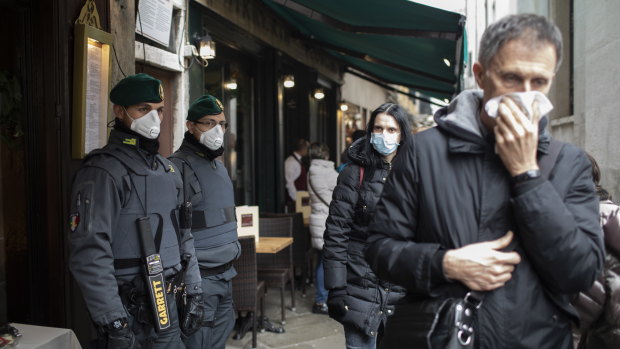This was published 4 years ago
Opinion
Fear factor: Global markets in turmoil as pandemic looms
Stephen Bartholomeusz
Senior business columnistIt’s not quite carnage yet but the big falls in overseas stock markets on Monday were a response to investor recognition that the coronavirus is not just a problem for China and perhaps the wider Asia-Pacific, nor just a blip in the global growth rate, but is rapidly becoming a global and more lasting threat.
Until it became clear that the virus had gained a beachhead in Europe, with parts of northern Italy in lockdown, financial markets had seen the economic effects of the virus as limited, confined mainly to China and likely to shave a couple of percentage points off China’s March-quarter GDP growth rate before business as usual resumed.

Wall Street has shed more than 5 per cent over the past two sessions. Credit: AP
Now, with the virus established in China, South Korea, Japan and Italy and cases emerging through the Middle East, it is clear that we are on the verge of a pandemic and that the disruption to global supply chains and business more generally is going to be deeper, more widespread and more persistent than anticipated.
Markets throughout Asia, Europe and the US tumbled on Monday as that realisation took hold.
Since Friday, the US sharemarket has fallen nearly 5 per cent. It fell about 3.5 per cent overnight while European markets were all down about 4 per cent.
The technology-laden "FAANG+" index – the core of which is provided by Facebook, Amazon, Apple, Netflix and Google – has fallen about 8 per cent.
That slump is probably a combination of the very high price-earnings ratios of tech companies being unwound and the real effects of the virus on those companies, such as Apple, Tesla and Alibaba, that have supply chains anchored within China or are exposed to Chinese consumers, or both.
The "fear index" – the VIX index, which reflects the expected levels of volatility in the US sharemarket – has spiked nearly 75 per cent since the middle of last week to its highest levels since the 20 per cent plunge in the market that occurred late in 2018.
The turmoil isn’t confined to equity markets.
Yields on 10-year US Treasury bonds have tumbled towards historic lows. At 1.37 per cent, the yield on those bonds is lower than the 1.53 per cent available from three-month Treasury notes – the US yield curve has inverted quite steeply.
An inverted yield curve – one where short term rates are higher than those on longer-term bonds – has pre-dated every US recession of the past half-century.

Towns in northern Italy are in lockdown as the coronavirus gains a beachhead in Europe.Credit: EPA
At the least, it presages an economic slowdown and as a signal is consistent with US purchasing managers’ index data last week that showed activity in factories and the service sector shrinking to its lowest level in 6½ years.
Given the nature of global supply chains and the global economy, with the leads and lags of orders and inventories, it was always going to take some time before the impact of the virus on economies outside of China began to show up clearly.
Within the next month or so the damage will become more evident and calculable and it will be easier to determine whether the virus has simply deferred activity to later in the year with – as occurred with the SARS epidemic – an eventual blitz of catch-up activity, or has resulted in a more structural reduction in global growth.
The longer the virus persists and the further it spreads, the more likely it will be the latter.
US bond market activity is telling because the trend in US yields had already diverged from what was, before fears of the virus spreading took hold last week, an ebullient stock market. Bond investors tend to be more conscious of risk and more risk-averse than investors in equities.
There had been something of a flight to safety occurring – a year ago the yield on 10-year bonds was 2.76 per cent and at the start of the year it was still 1.92 per cent – even as the sharemarket was posting records that seemed out of kilter with the relatively modest growth occurring in the US economy. The directions of the two markets are now in an apprehensive sync.
The bond market inversion probably owes something to the flight to safety, with investors looking for somewhere safe to park their cash until the ultimate impact of the epidemic becomes clearer.
The US dollar, which has strengthened about 2 per cent against America’s major trading partners this month, probably also reflects that same shift in appetites for risk.
There may be another influence behind the falls in yields. The market is now effectively pricing in two US Federal Reserve rate cuts this year, assigning a near 75 per cent probability to the prospect the Fed will be forced to respond to a slowing of the US economy.
If that were to occur, our Reserve Bank would, incidentally, almost inevitably be forced to follow suit to avoid the risk of the Australian dollar strengthening and adding to the economic fallout from the woes within our biggest trading partner. The RBA might in any event decide it is necessary to cut rates further to soften the impact of the regional economic dislocation.